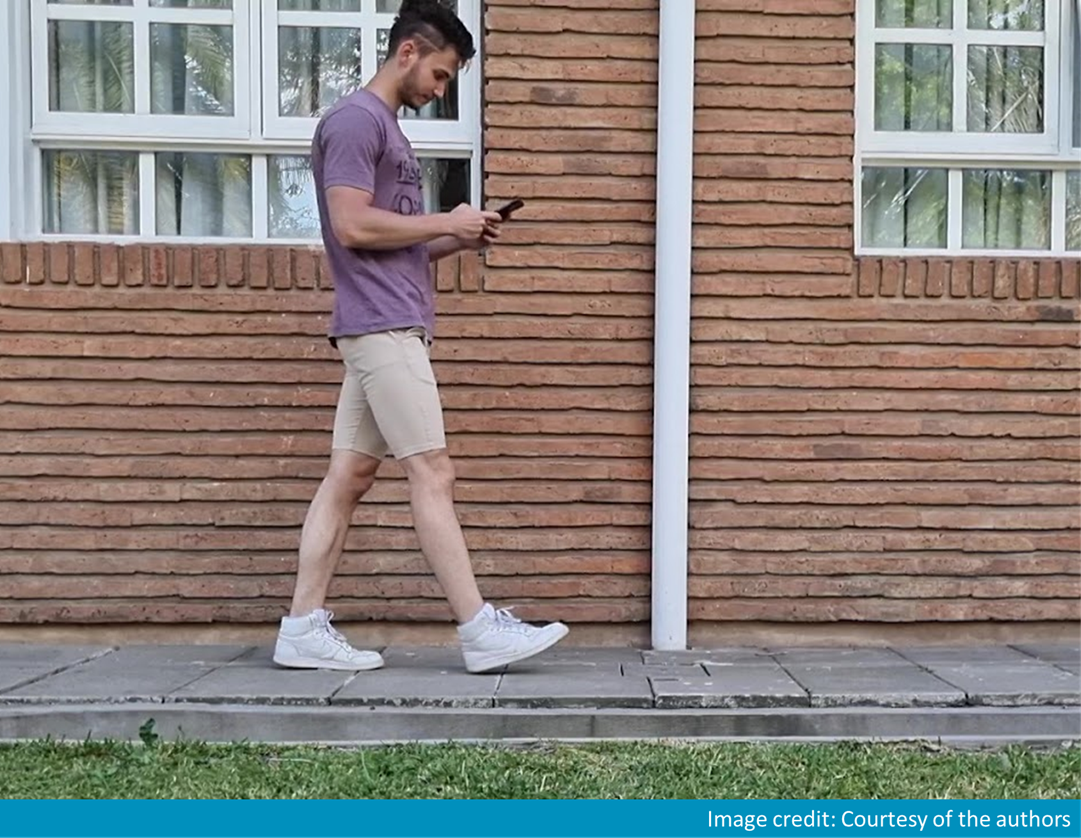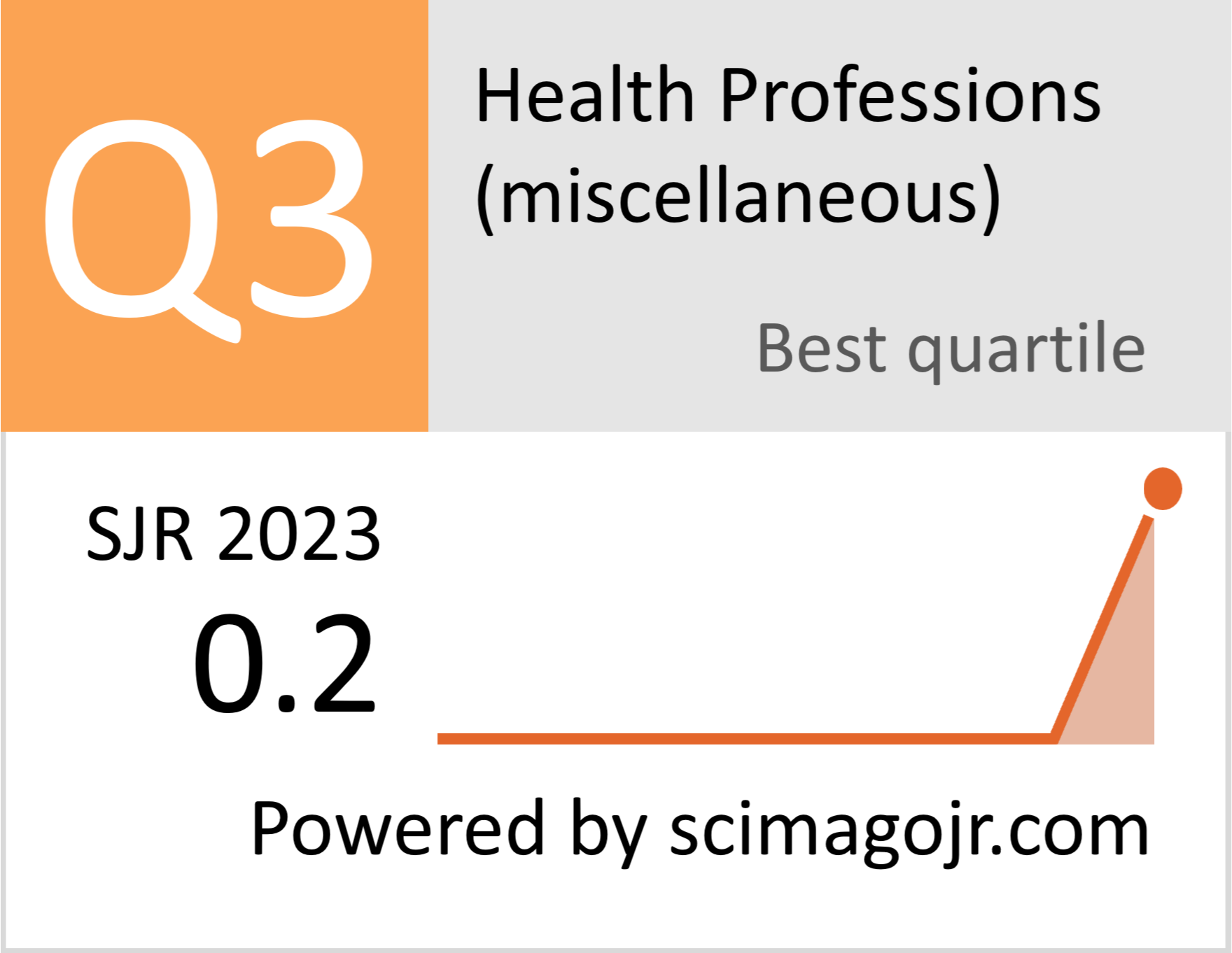El uso de smartphones afecta los parámetros espaciotemporales de la marcha, pero no la simetría, en adultos jóvenes que caminan al aire libre
Smartphone Use Affects Spatio-Temporal Gait Parameters but Not Gait Symmetry in Young Adults Walking Outdoors

Esta obra está bajo una licencia internacional Creative Commons Atribución-NoComercial-SinDerivadas 4.0.
Mostrar biografía de los autores
Introducción. Los smartphones son esenciales en la vida diaria. Sin embargo, se ha reportado que algunos parámetros espacio-temporales de la marcha cambian cuando se utiliza un smartphone en espacios interiores y controlados.
Objetivo. Estudiar el impacto del smartphone sobre los parámetros espaciotemporales y simetría de la marcha en adultos jóvenes, caminando al aire libre.
Método. Videos de 35 adultos jóvenes sanos (14 mujeres, rango de edad de edad de 18 a 28 años) fueron registrados en un pasillo exterior bajo dos condiciones de marcha: caminata habitual y caminata escribiendo en un smartphone con ambas manos. Los videos fueron analizados para el cálculo de parámetros y simetría.
Resultados. Los resultados mostraron que, durante la caminata con el uso del smartphone, los sujetos caminaron a una menor velocidad (P< 0.0001), con un mayor tiempo del ciclo (P< 0,0001), tiempo de paso (P< 0,0001) y tiempo de apoyo (P< 0,0001), en comparación con la caminata habitual. Sin embargo, la simetría en los tiempos no mostró diferencias para ninguno de los parámetros analizados (P>0.05).
Conclusión. El uso de smartphone mientras se camina afecta los parámetros espacio-temporales de la marcha, adoptando una disminución de la velocidad de marcha y adecuando los tiempos consecuentemente, pero la marcha mantiene la simetría entre miembros inferiores. Es posible que estos cambios tengan el objetivo de aumentar la estabilidad y la capacidad de equilibrio y así mejorar la seguridad de las personas cuando caminan con atención dividida.
Visitas del artículo 31 | Visitas PDF 17
- Gelles-Watnick R. Americans’ Use of Mobile Technology and Home Broadband [Internet]. Washington DC: Pew Research Center; c2025 [updated 2024 Jan 31]; [about 6 screens]. Available from: https://www.pewresearch.org/internet/2024/01/31/americans-use-of-mobile-technology-and-home-broadband/
- Lee U, Lee PH. Editorial: Adverse health consequences of excessive smartphone usage, volume II. Front Public Health [Internet]. 2022;10:984398. doi: https://doi.org/10.3389/fpubh.2022.984398
- Lam WK, Liu RT, Chen B, Huang XZ, Yi J, Wong DWC. Health Risks and Musculoskeletal Problems of Elite Mobile Esports Players: a Cross-Sectional Descriptive Study. Sports Med Open [Internet]. 2022;8(1):65. doi: https://doi.org/10.1186/s40798-022-00458-3
- Adamczewska-Chmiel K, Dudzic K, Chmiela T, Gorzkowska A. Smartphones, the Epidemic of the 21st Century: A Possible Source of Addictions and Neuropsychiatric Consequences. Int J Environ Res Public Health [Internet]. 2022;19(9):5152. doi: https://doi.org/10.3390/ijerph19095152
- Lim J, Amado A, Sheehan L, Van Emmerik REA. Dual task interference during walking: The effects of texting on situational awareness and gait stability. Gait Posture [Internet]. 2015;42(4):466-71. doi: http://dx.doi.org/10.1016/j.gaitpost.2015.07.060
- Strubhar AJ, Peterson ML, Aschwege J, Ganske J, Kelley J, Schulte H. The effect of text messaging on reactive balance and the temporal and spatial characteristics of gait. Gait Posture [Internet]. 2015;42(4):580-3. doi: http://dx.doi.org/10.1016/j.gaitpost.2015.09.007
- Tandon R, Javid P, Di Giulio I. Mobile phone use is detrimental for gait stability in young adults. Gait Posture [Internet]. 2021;88:37-41. doi: https://doi.org/10.1016/j.gaitpost.2021.05.001
- Mirelman A, Shema S, Maidan I, Hausdorff JM. Chapter 7 - Gait. Handb Clin Neurol [Internet]. 2018;159:119-34. doi: https://doi.org/10.1016/B978-0-444-63916-5.00007-0
- Gandolfi M, Fiorio M, Geroin C, Torneri P, Menaspà Z, Smania N, et al. Dual tasking affects gait performance but not automaticity in functional gait disorders: A new diagnostic biomarker. Parkisonism Relat Disord [Internet]. 2023;108:105291. doi: https://doi.org/10.1016/j.parkreldis.2023.105291
- Smeeton NJ, Wrightson J, Varga M, Cowan R, Schafer L. Coordination between motor and cognitive tasks in dual task gait. Gait Posture [Internet]. 2021;85:138-44. doi: https://doi.org/10.1016/j.gaitpost.2021.01.012
- Brennan AC, Breloff SP. The effect of various cell phone related activities on gait kinematics. J Musculoskelet Res [Internet]. 2019;22(3-4). doi: https://doi.org/10.1142/S0218957719500118
- Martín-Martínez JP, Villafaina S, Collado-Mateo D, Fuentes-García JP, Pérez-Gómez J, Gusi N. Impact of cognitive tasks on biomechanical and kinematic parameters of gait in women with fibromyalgia: A cross-sectional study. Physiol Behav [Internet]. 2020;227:113171. doi: https://doi.org/10.1016/j.physbeh.2020.113171
- Hennah C, Doumas M. Dual-task walking on real-world surfaces: Adaptive changes in walking speed, step width and step height in young and older adults. Exp Gerontol [Internet]. 2023;177:112200. doi: https://doi.org/10.1016/j.exger.2023.112200
- Almajid R, Appiah-Kubi KO, Cipriani D, Goel R. Dual-tasking interference is exacerbated outdoors: A pilot study. Front Sport Act Living [Internet]. 2023;5:1077362. doi: https://doi.org/10.3389/fspor.2023.1077362
- Vanderhoof HR, Chavez EA, Eggleston JD. Gait Symmetry Is Unaffected When Completing a Motor Dexterity Task While Using a Walking Workstation in Healthy, Young Adults. Biomechanics [Internet]. 2022;2(3):431-40. doi: https://doi.org/10.3390/biomechanics2030033
- Thompson LL, Rivara FP, Ayyagari RC, Ebel BE. Impact of social and technological distraction on pedestrian crossing behaviour: an observational study. Inj Prev [Internet]. 2013;19(4):232-7. doi: https://doi.org/10.1136/injuryprev-2012-040601
- Whittle MW. Gait Analysis - An Introduction [Internet]. 4th ed. Amsterdam: Elsevier; 2007. doi: https://doi.org/10.1016/B978-0-7506-8883-3.X5001-6
- Baker R, Esquenazi A, Benedetti MG, Desloovere K. Gait analysis: clinical facts. Eur J Phys Rehabil Med [Internet]. 2016;52(4):560-74. Available from: https://www.minervamedica.it/en/journals/europa-medicophysica/article.php?cod=R33Y2016N04A0560
- Arauz PG, Garcia MG, Chiriboga P, Okushiro V, Vinueza B, Fierro K, et al. In-vivo 3-dimensional spine and lower body gait symmetry analysis in healthy individuals. Heliyon [Internet]. 2024;10(7):e28345. doi: https://doi.org/10.1016/j.heliyon.2024.e28345
- Smith E, Cusack T, Cunningham C, Blake C. The influence of a cognitive dual task on the gait parameters of healthy older adults: A systematic review and meta-analysis. J Aging Phys Act [Internet]. 2017;25(4):671-86. doi: https://doi.org/10.1123/japa.2016-0265
- Jungen P, Batista JP, Kirchner M, Habel U, Bollheimer LC, Huppertz C. Variability and symmetry of gait kinematics under dual-task performance of older patients with depression. Aging Clin Exp Res [Internet]. 2023;35(2):283-91. doi: https://doi.org/10.1007/s40520-022-02295-6
- Gillain S, Boutaayamou M, Schwartz C, Dardenne N, Bruyère O, Brüls O, et al. Gait symmetry in the dual task condition as a predictor of future falls among independent older adults: a 2-year longitudinal study. Aging Clin Exp Res [Internet]. 2019;31(8):1057-67. doi: https://doi.org/10.1007/s40520-019-01210-w
- Plotnik M, Bartsch RP, Zeev A, Giladi N, Hausdorff JM. Effects of walking speed on asymmetry and bilateral coordination of gait. Gait Posture [Internet]. 2013;38(4):864-9. doi: https://doi.org/10.1016/j.gaitpost.2013.04.011
- Goble DJ, Marino GW, Potvin JR. The influence of horizontal velocity on interlimb symmetry in normal walking. Hum Mov Sci [Internet]. 2003;22(3):271-83. doi: https://doi.org/10.1016/S0167-9457(03)00047-2
- Castro-Medina KG. Effects of Visual Feedback on Walking Speed for Stroke Patients: Single-case Design. Rev Investig Innov Cienc Salud [Internet]. 2023;5(1):127-43. doi: https://doi.org/10.46634/riics.153
- Duré CI, Savio J, Marengo B, Perotti G, Formento PC, Bonell CE. Protocol for the Functional Evaluation of Patients with Knee Injury Treated in a Local Rehabilitation Centre. IFMBE Proceedings [Internet]. 2020;75:907-12. doi: https://doi.org/10.1007/978-3-030-30648-9_117
- Bertot A, Barrera V, Dutto CI, Bernal C, Catalfamo Formento PA. Análisis de marcha en amputados: prueba piloto. Ortesis, Prótesis y Movilidad. 2019;2(1):34-7.
- Bertot A, Dutto CI, Barrera V, Bernal C, Bonell C, Catalfamo Formento P. Análisis del movimiento clínico. In Mercante S, editor. 2019 Iberdiscap. X Congreso Iberoamericano de Tecnologías de Apoyo a la Discapacidad. Buenos Aires 20 21 y 22 de noviembre; 2019 Nov 20 – Nov 23; Centro Cultural de la Ciencia, Argentina. General San Martín: Instituto Nacional de Tecnología Industrial; 2020. p. 84-85. Available from: https://thegardenofcuriosity.untref.edu.ar/img/18_c3d/PDF_C3D_Publicacio%CC%81n-IBERDISCAP_01.pdf
- Riveras M, Ravera E, Shaheen AFF, Ewins D, Catalfamo-Formento P, Catalfamo Formento P. Spatio temporal parameters and symmetry in subjects ascending and descending a ramp, using three different prosthetic feet. Journal of mechanical science and technology [Internet]. 2020;34:955-61. doi: https://doi.org/10.1007/s12206-020-0145-0
- Riveras M, Ravera E, Shaheen AFF, Ewins D, Catalfamo Formento P. Spatio Temporal Parameters and Symmetry Index in Transtibial Amputees Wearing Prosthetic Feet with and without Adaptive Ankles. In: Leija Salas L, editor. 2019 Global Medical Engineering Physics Exchanges/ Pan American Health Care Exchanges (GMEPE/PAHCE) [Internet]. 2019 March 26-31. Buenos Aires, Argentina: GMEPE/PAHCE; 2019. p. 1-6. doi: https://doi.org/10.1109/GMEPE-PAHCE.2019.8717362
- Zhang X, Li Q, Gao P, Zhu J, Tuo H, Lin Q, et al. The effect of mobile phone task and age on gait: A systematic review and meta-analysis. Front Physiol [Internet]. 2023;14:1163655. doi: https://doi.org/10.3389/fphys.2023.1163655
- Prupetkaew P, Lugade V, Kamnardsiri T, Silsupadol P. Cognitive and visual demands, but not gross motor demand, of concurrent smartphone use affect laboratory and free-living gait among young and older adults. Gait Posture [Internet]. 2019;68:30-6. doi: https://doi.org/10.1016/j.gaitpost.2018.11.003
- Krasovsky T, Weiss P, Kizony R. Older adults pay an additional cost when texting and walking: effects of age, environment and use of mixed reality on dual-task performance. Phys Ther [Internet]. 2018;98(7):549-59. doi: https://doi.org/10.1093/ptj/pzy047
- Llanga Vargas EF, Logacho G, Molina L. La memoria y su importancia en los procesos cognitivos en el estudiante. Cuadernos de Educación y Desarrollo [Internet]. 2019;(8). Available from: https://www.eumed.net/rev/atlante/2019/08/memoria-importancia-estudiante.html
- Frisoli M, Poux S, Deris M, Catalfamo-Formento P, García-Añino E. Documentation Tools Development for Rehabilitation Technology Implementation. IFMBE Proceedings [Internet]. 2024;105:305-14. doi: https://doi.org/10.1007/978-3-031-51723-5_38
- Primosich CV, Molaro Battisti MA, Catalfamo-Formento P, Valotto VO, Bonell CE. Functional Design of Sofware to Obtain Spatio-Temporal Parameters of Human Gait. In: IFMBE Proceedings 105 [Internet]. 2024;105:85-92 [Internet] , https://doi.org/10.1007/978-3-031-51723-5_10
- Peterson M V, Ewins D, Shaheen A, Catalfamo Formento PA. Evaluation of Methods Based on Conventional Videography for Detection of Gait Events. IFMBE Proceedings [Internet]. 2015;49:234-7. doi: https://doi.org/10.1007/978-3-319-13117-7_61
- Arcila Cano A, Ewins D, Shaheen A, Catalfamo Formento P. Evaluation of methods based on conventional videography for detection of gait events. IFMBE Proceedings [Internet]. 2017;60:181-4. doi: https://doi.org/10.1007/978-981-10-4086-3_46
- De Grucci C, Ewins D, Shaheen A, Catalfamo Formento P. Evaluation of a visual method to calculate temporal parameters. In: 2016 IEEE Biennial Congress of Argentina (ARGENCON) [Internet]. 2016 Jun 15-17. Buenos Aires, Argentina: IEEE ARGENCON. p. 1-6. doi: https://doi.org/10.1109/ARGENCON.2016.7585312
- De Grucci C, Bonell CE, Dutto CI, Barrera V, Bernal C, Catalfamo Formento PA. Gait Analysis through a visual method to calculate temporal parameters: comparison of performance between the gait laboratory and the clinical setting. Revista Argentina de Bioingeniería [Internet]. 2019;23(2):3-8. Available from: https://ri.conicet.gov.ar/handle/11336/107371
- Deris M, Poux S, García-Añino E, Frisoli M. Desarrollo de herramientas documentales para la obtención de variables de la marcha humana mediante el uso del software HAPET [First Degree Thesis]. Universidad Nacional de Entre Ríos; 2022 . 130 p.
- Cámara Tobalina J. Análisis de la marcha: sus fases y variables espacio-temporales. Entramado [Internet]. 2011;7(1):160-73. Available from: http://www.scielo.org.co/scielo.php?script=sci_arttext&pid=S1900-38032011000100011&lng=en&nrm=iso&tlng=es
- Marinakis GNS. Interlimb symmetry of traumatic unilateral transtibial amputees wearing two different prosthetic feet in the early rehabilitation stage. J Rehabil Res Dev [Internet]. 2004;41(4):581-90. doi: https://doi.org/10.1682/JRRD.2003.04.0049
- Kim SH, Jung JH, Shin HJ, Hahm SC, Cho HY. The impact of smartphone use on gait in young adults: Cognitive load vs posture of texting. PLoS One [Internet]. 2020;15(10):e0240118. doi: http://dx.doi.org/10.1371/journal.pone.0240118
- Krasovsky T, Weiss PL, Kizony R. A narrative review of texting as a visually-dependent cognitive-motor secondary task during locomotion. Gait Posture [Internet]. 2017;52:354-62. doi: http://dx.doi.org/10.1016/j.gaitpost.2016.12.027
- Seymour KM, Higginson CI, DeGoede KM, Bifano MK, Orr R, Higginson JS. Cellular Telephone Dialing Influences Kinematic and Spatiotemporal Gait Parameters in Healthy Adults. J Mot Behav [internet]. 2016;48(6):535-41. doi: https://doi.org/10.1080/00222895.2016.1152226
- Zhang H, Zhang C, Chen F, Wei Y. Effects of mobile phone use on pedestrian crossing behavior and safety at unsignalized intersections. Canadian Journal of Civil Engineering [Internet]. 2019;46(5):381-8. doi: https://doi.org/10.1139/cjce-2017-0649
- Zhou Z, Liu S, Xu W, Pu Z, Zhang S, Zhou Y. Impacts of mobile phone distractions on pedestrian crossing behavior at signalized intersections: An observational study in China. Advances in Mechanical Engineering [Internet]. 2019;11(4):1-8. doi: https://doi.org/10.1177/1687814019841838
- Błazkiewicz M, Wiszomirska I, Wit A. Comparison of four methods of calculating the symmetry of spatial-temporal parameters of gait. Acta Bioeng Biomech. 2014;16(1):29-35.



